** The Engine Room Tour**
Chief Engineer Don Stortts kindly gave us an engine systems tour today. Don has been going to sea for 36 years, and he clearly knows this ship. His knowledge and enthusiasm made the tour truly fascinating. Here is what I learned.
The LSSL is propelled by a diesel/ electric motor system. Diesel fuel is used to power five generators producing 6600 volts AC each.
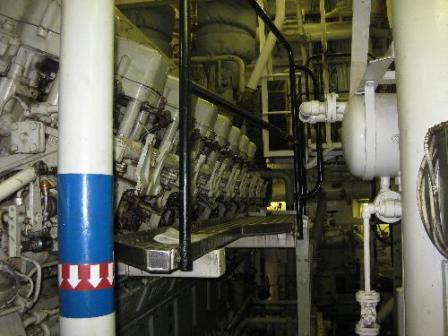 This is a very small part of the engine. Watch the video to get a sense of the size and sound of the engine room.
This is a very small part of the engine. Watch the video to get a sense of the size and sound of the engine room.
This voltage is converted to 900 volts DC to run three motors, each powering one of three propellers. Each propeller is 4575mm (about 15 feet) in diameter and weighs 24,634 kg (about 54,000 pounds). The ship weighs 13000 tons.
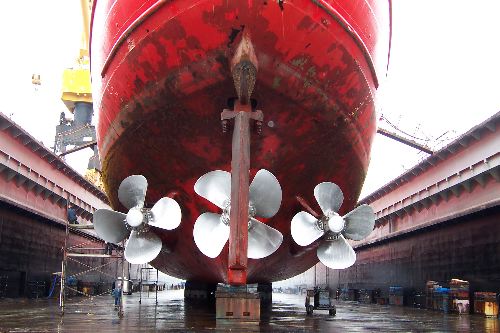 The LSSL in dry dock in Halifax. Stern view. Note man in lower left for perspective. Courtesy of Don Stortts.
The LSSL in dry dock in Halifax. Stern view. Note man in lower left for perspective. Courtesy of Don Stortts.
Question: Though it is so heavy, why does the ship float?
The ship can carry 3.6 million liters of fuel, and needs a 7000-liter oil change at least every 5000 hours. Just in case, the LSSL carries 60,000 liters of extra oil.....
The thrust developed by the propeller is transferred to the ship via the thrust box. It seems quite small inconsequential for its major role in ship movement. There are three, one on each propeller shaft.
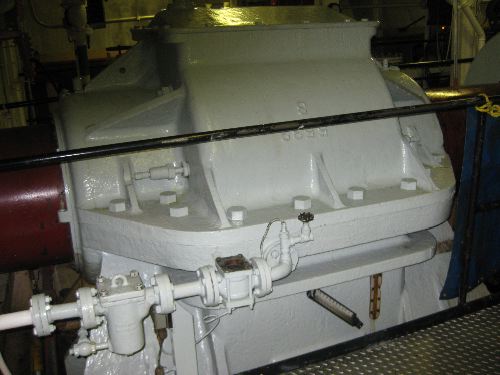 This rather small and simple looking hunk of metal is the thrust block. It transfers the thrust developed by the propellers to the ship.
This rather small and simple looking hunk of metal is the thrust block. It transfers the thrust developed by the propellers to the ship.
Question: what would happen if the thrust was NOT transferred to the ship?
The engine room is loud. I will post a video below to give you a real sense of its action!
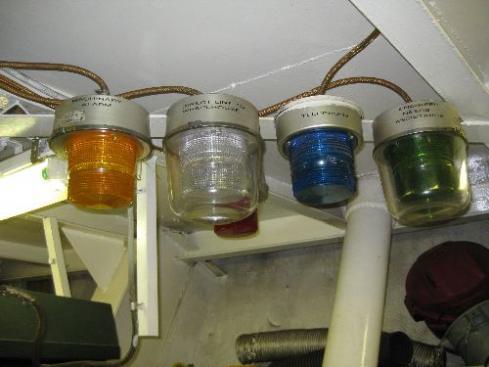 The engine room is loud. We wore ear plugs. When working, communication is best done using lights. Each color represents a different signal.
The engine room is loud. We wore ear plugs. When working, communication is best done using lights. Each color represents a different signal.
The rudder steers the ship. On an icebreaker, there are extra features such as ice horn above to deflect ice away from the rudder stock (the post). The rudder stop keeps the rudder from being defected too far over if it is pushed by a hunk of ice. Yes, hunks of ice can weigh more than the ship.
 The LSSL in drydock. Note the *ice horn* above the rudder. This keeps ice away from the rudder rod. The bow also has an *ice knife* to keep the ship from *dry docking* itself up on a piece of ice. Courtesy of Don Stortts.
The LSSL in drydock. Note the *ice horn* above the rudder. This keeps ice away from the rudder rod. The bow also has an *ice knife* to keep the ship from *dry docking* itself up on a piece of ice. Courtesy of Don Stortts.
The Engineering team can do almost anything. They carry tools, spare parts and the knowledge to repair and maintain every part of the ship. And, if they do not have a part, they can make it.
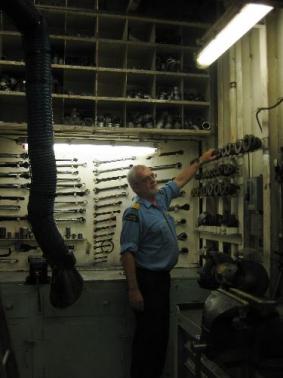 The tool room with everything, absolutely everything! *We can repair anything except a broken heart.*
The tool room with everything, absolutely everything! *We can repair anything except a broken heart.*
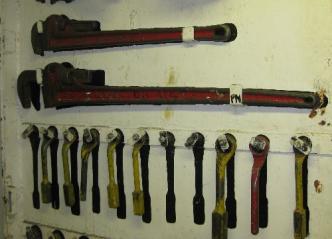 Big Red, the biggest monkey wrench.
Big Red, the biggest monkey wrench.
The ship's distiller use the steam from the boiler to boil the water. This process is done under a vacuum to lower the boiling point to about 70C so it requires less input energy. But this is not hot enough to sterilize, so chlorine is added to 0.2/0.5 parts per million (just like municipal water supplies). The ship is currently using about 20 tons of water a day.
Everything is burned, except hazard waste and recyclables. The incinerator works 24/7 just like the crew and scientists.
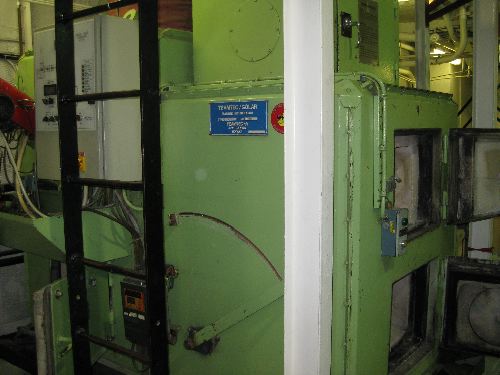 The ship's incinerator-- here all garbage is burned, except hazardous waste. None is put into the ocean. The Arctic has a *zero discharge* rule: nothing considered a pollutant may be discharged, dumped, from the ship.
The ship's incinerator-- here all garbage is burned, except hazardous waste. None is put into the ocean. The Arctic has a *zero discharge* rule: nothing considered a pollutant may be discharged, dumped, from the ship.
Don took us everywhere, even places I decided not to go to.....
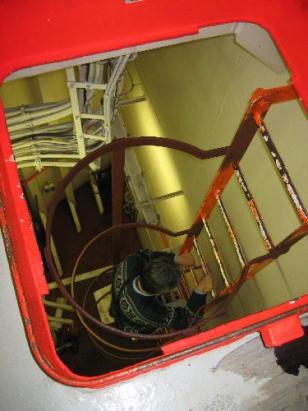 The ladder to the Bubbler motor. The ship was rolling quite a bit so I decided not to go down. Edmand went. Ships are inherently dangerous places, so for your safety you should know and respect your limits.
The ladder to the Bubbler motor. The ship was rolling quite a bit so I decided not to go down. Edmand went. Ships are inherently dangerous places, so for your safety you should know and respect your limits.
After our tour, Don answered our many questions. Thank you Don! He left us with this thought:
"what good is an ice breaker without an ice maker?"
So long, for now, from the Louis!
Check Out the Video!
http://

